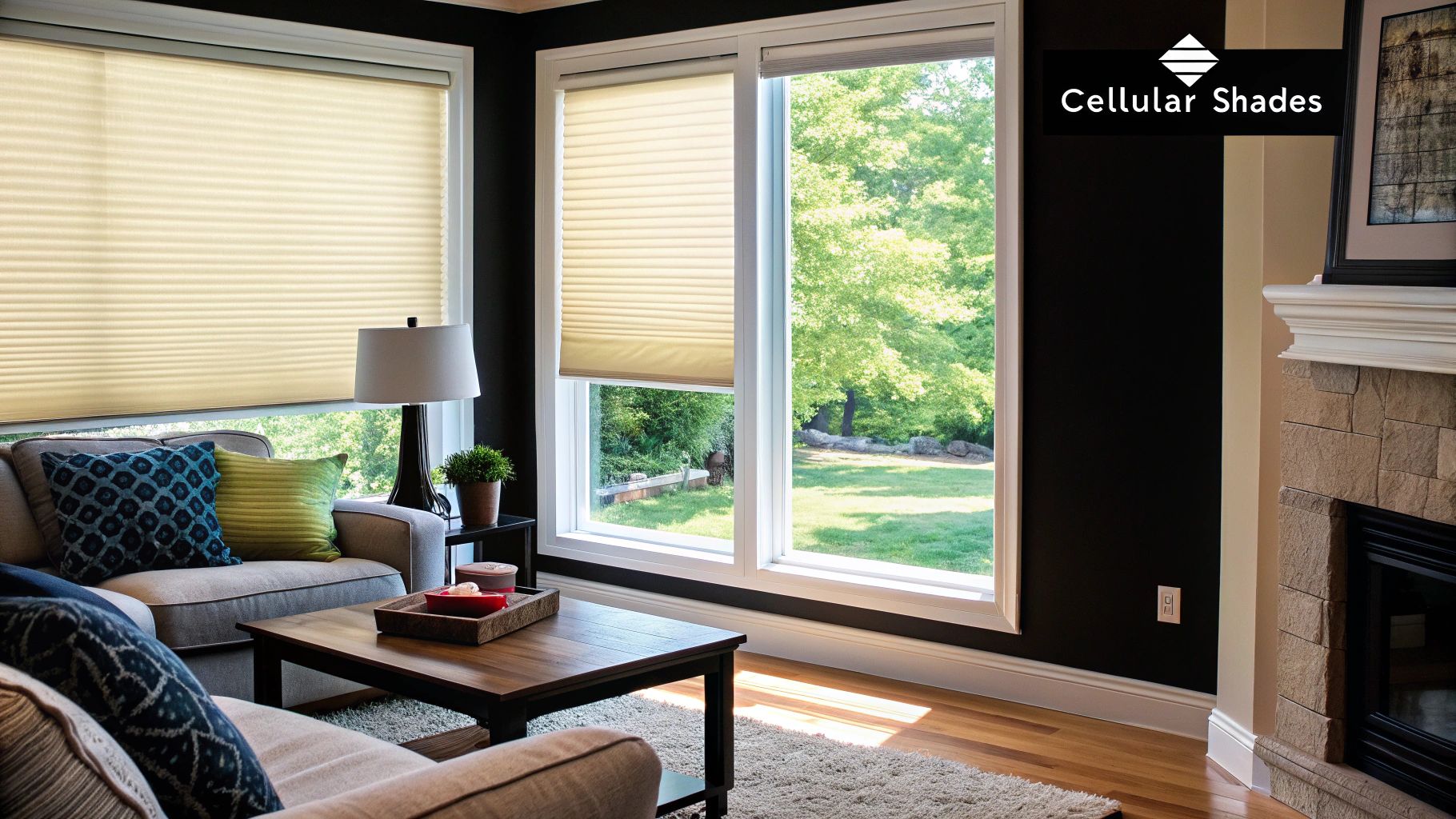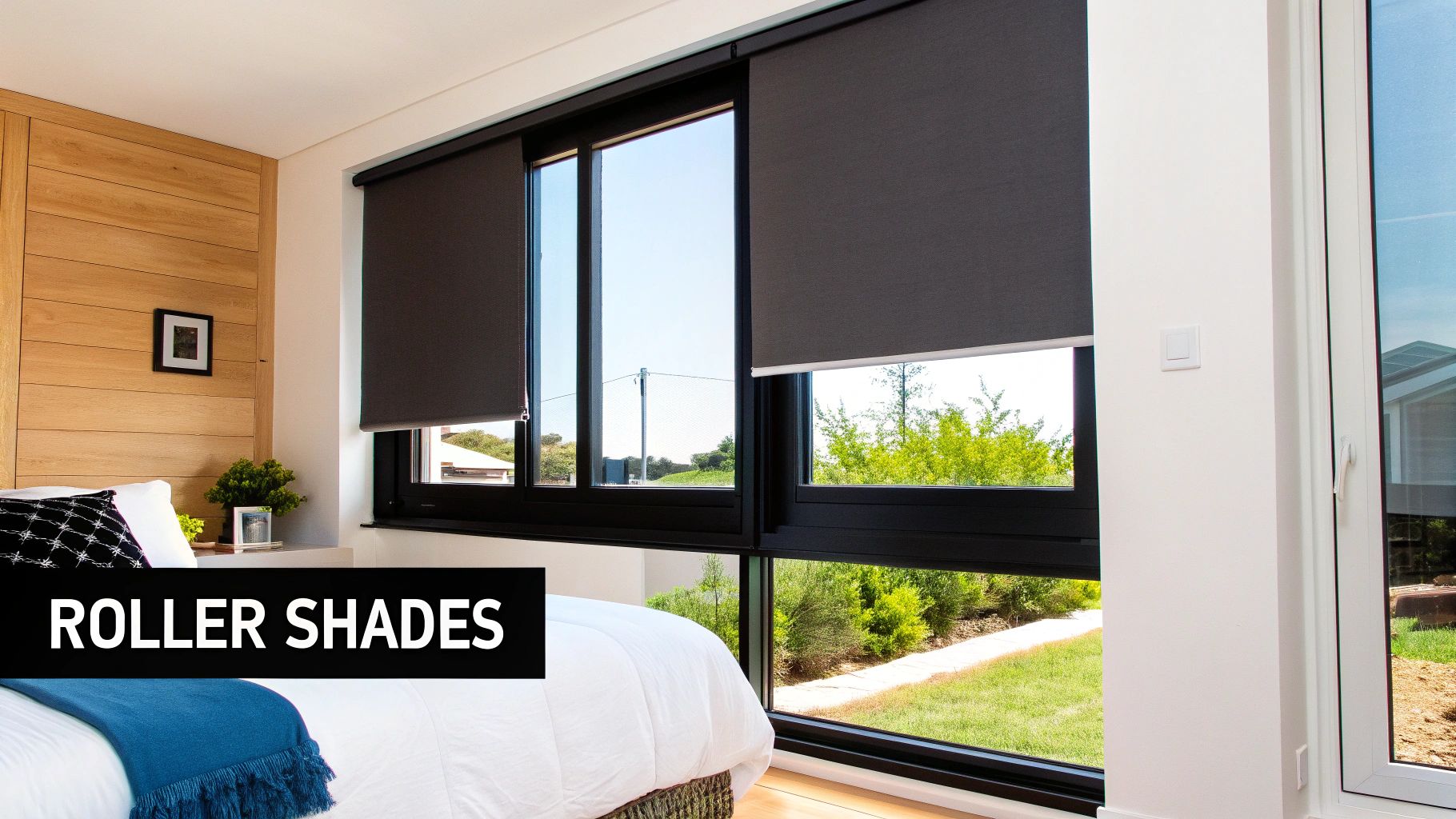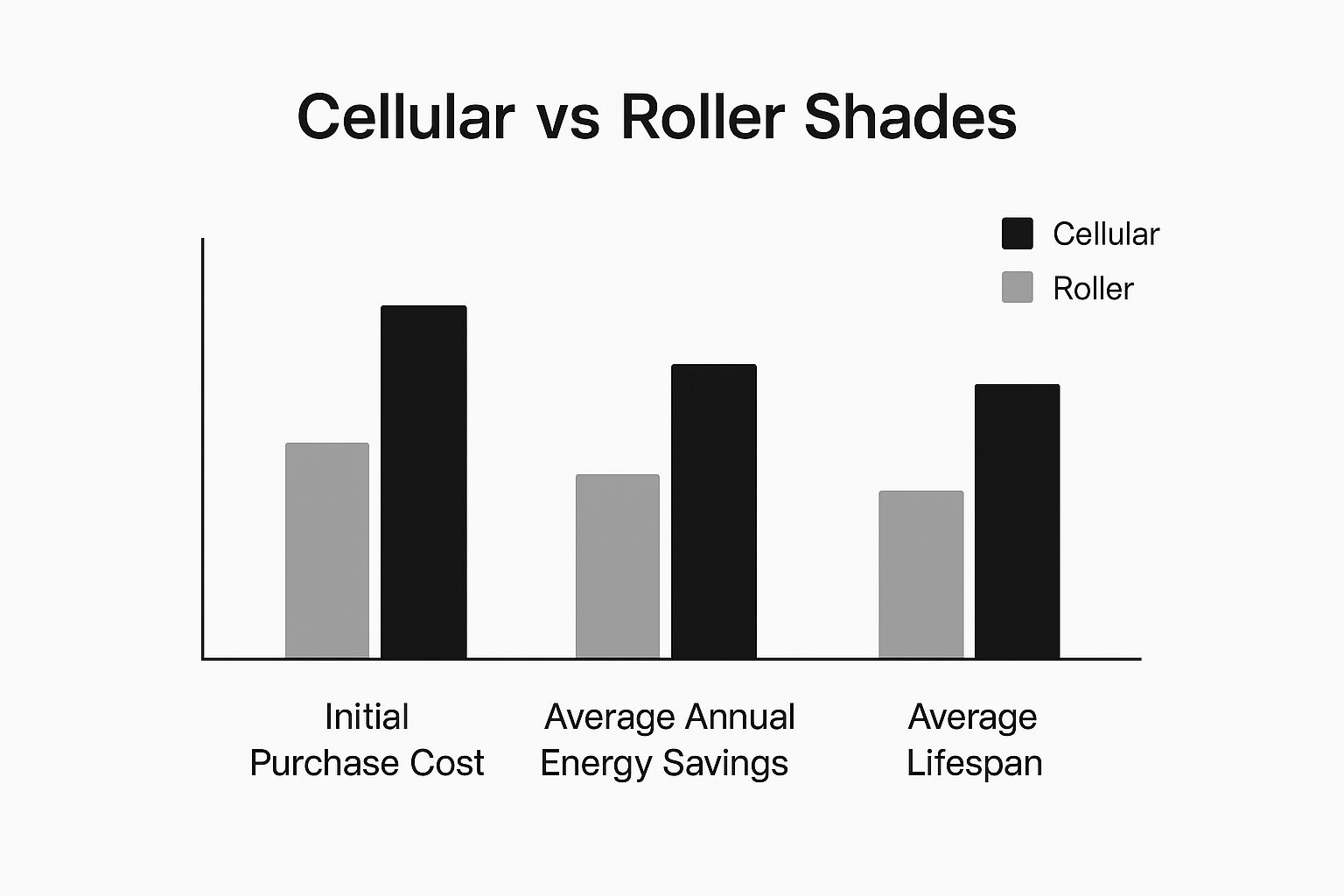Cellular vs Roller Shades: Which Window Treatment Is Best?
- Johann Reardon

- Jul 18
- 12 min read
Making Sense of Your Window Treatment Decision
Let's be honest—choosing between window treatments can feel overwhelming when you're staring at countless options. The cellular vs. roller shades decision, in particular, goes far beyond simply picking what looks nice. It’s about how your choice will integrate into your daily life. This is why we focus on what actually matters for your specific situation, moving past marketing noise to deliver practical guidance.
Your Guide to a Confident Choice
Through years of conversations with homeowners, the team at Home Blinds & Floors has learned which factors truly impact long-term satisfaction. It’s rarely about a single feature; it's about the right combination of benefits for your home's unique needs. We’ve seen firsthand how a family might choose cellular shades for superior insulation in a drafty bedroom, while opting for sleek roller shades in a modern kitchen to resist moisture and simplify cleaning. These real-world applications highlight that the "best" shade is entirely contextual.
Beyond Aesthetics: Function and Lifestyle
Thinking about your daily routine is critical. Do you need to eliminate screen glare in a home office? Or do you want soft, diffused light for a relaxing living room? We will explore honest perspectives from specialists who have installed both types of shades for years, helping you avoid common mistakes that can lead to buyer's remorse. By focusing on practical insights, you'll gain the confidence to select a window treatment that not only enhances your decor but also improves your home's comfort and functionality. This approach ensures your investment provides value and satisfaction for years to come.
Why These Two Shade Types Dominate the Market

It’s no accident that cellular and roller shades have become so common in homes today. Their popularity signals a clear shift in what homeowners value: energy efficiency and clean, modern aesthetics. As utility costs climb and architectural trends lean toward minimalist, open-concept spaces, these two window treatments have become the go-to solutions because they meet these needs head-on. Unlike older, heavier styles, both offer a streamlined profile that fits perfectly into contemporary homes without giving up performance.
Evolving Consumer Demands
The heart of the cellular vs. roller shades discussion usually centers on which specific problem a homeowner is looking to solve. Each style has carved out its niche by addressing distinct, modern-day needs.
Cellular shades are a direct answer for the energy-conscious homeowner. Their unique honeycomb structure is a practical solution designed to combat high energy bills and reduce a home's environmental footprint by providing excellent insulation.
Roller shades appeal to those who prioritize aesthetic flexibility and simplicity. With their crisp lines and a massive selection of fabrics, they can be anything from a subtle, functional backdrop to a bold design statement.
This trend is seen globally, but it’s especially prominent in North America, which accounts for a leading 39.25% share of the worldwide blinds and shades market revenue. This market position is heavily supported by strong consumer interest in energy-saving products—a key feature of cellular shades. At Home Blinds & Floors, we see these preferences every day as we guide homeowners toward the right balance of style and function for their spaces. You can find more information on the market forces shaping these trends from detailed industry research.
The Energy Efficiency Reality Check
When comparing cellular vs. roller shades, the most significant performance difference is in energy efficiency. This isn't just a minor detail; it’s a characteristic that can directly influence your monthly utility bills. The architectural design of cellular shades is their greatest strength. Their honeycomb pockets trap air, creating a natural insulating barrier that slows the transfer of heat. A roller shade, by contrast, functions more like a simple shield, with its insulating power determined almost entirely by the fabric's material and thickness.
The Science of Savings
The effectiveness of cellular shades is well-documented. Studies show that properly installed, insulated cellular shades can reduce heat loss through windows by approximately 40%. This can translate to about 10% in overall heating energy savings, making them a formidable choice in climates with cold winters. You can learn more about how market trends reflect this in detailed research reports.
However, a roller shade can still contribute to energy management. A high-quality, opaque blackout roller shade will effectively block solar heat gain in the summer, keeping rooms cooler and reducing the strain on your air conditioning. The key is understanding that their primary energy benefit is blocking direct sunlight rather than providing thermal insulation. This makes them a practical choice for sun-drenched rooms in warmer climates.
Maximizing Your Investment
To make a smart decision, consider your home’s specific needs. At Home Blinds & Floors, our in-home consultations help homeowners analyze factors like window orientation and local climate to determine which shade offers the best return on investment.
For instance, a double-cell cellular shade might be ideal for a drafty north-facing window. On the other hand, a light-colored solar roller shade could be perfect for a west-facing living room to cut glare without sacrificing the view. For a deeper dive into making your windows work for you year-round, check out our comprehensive guide to energy-efficient window treatments across all seasons.
Mastering Light Control for Every Room

Effective light control is the difference between a window treatment you love and one you constantly fight with. When comparing cellular vs roller shades, their approaches to managing light are fundamentally different. Cellular shades provide nuanced light filtering, with their layered fabric construction creating a soft, ambient glow. This makes them excellent for living rooms or dining areas where gentle, diffused light is preferred.
Roller shades, however, offer more of an "on/off" switch for light. They excel at providing either significant transparency with sheer fabrics or complete darkness with blackout materials. This makes them a superior choice for specific needs, like protecting furniture from UV rays while preserving a view or achieving total darkness in a media room. The decision comes down to whether you need gentle moderation or absolute control.
Situational Light Management
Consider a common challenge: an east-facing bedroom that gets blasted with morning sun. A light-filtering cellular shade might soften the intensity but may not be enough for someone who wants to sleep in. In this case, a blackout roller shade would be the more practical solution. Conversely, for a home office with persistent screen glare, a light-filtering cellular shade can cut the harshness without plunging the room into darkness. If you need complete darkness, our guide on the best blackout shades for perfect light control can offer more specialized advice.
To help you visualize how these shades perform in different settings, the table below breaks down their practical strengths and weaknesses based on specific lighting needs.
Light Control Comparison: Real-World Performance Analysis | |||
|---|---|---|---|
Lighting Need | Cellular Shades Performance | Roller Shades Performance | Best Choice Scenario |
Reducing harsh glare in a home office | Excellent. Light-filtering fabrics diffuse direct sunlight, softening it to prevent screen glare while keeping the room bright. They provide a comfortable working ambiance without creating a dark, cave-like environment. | Good, but less nuanced. A light-filtering roller shade works, but a solar screen offers better view-through. A blackout roller is too extreme. The fabric choice is critical to avoid making the room too dark or not cutting enough glare. | Cellular Shades: For creating a soft, productive atmosphere where natural light is still a priority. |
Achieving total darkness in a media room or bedroom | Good, but with limitations. Blackout cellular shades have tiny cord holes that can allow pinpricks of light through. While they block most light, they may not achieve 100% darkness. | Excellent. Blackout roller shades made from a single, solid piece of fabric offer superior light-blocking capabilities. When combined with side channels, they can create a true room-darkening effect with no light gaps. | Roller Shades: For anyone who needs absolute, pitch-black conditions for sleep or home theater viewing. |
Preserving an outside view while blocking UV rays | Not ideal for this specific need. Cellular shades provide privacy and light filtering, but their opaque, honeycomb structure completely obstructs the view. You can see light, but not shapes or scenery outside. | The best option. Solar roller shades are specifically designed for this purpose. Their screen-like material blocks up to 99% of UV rays and cuts glare while maintaining a clear view of the outdoors. Opacity levels (e.g., 1%, 3%, 5%) let you fine-tune the view. | Roller Shades: Specifically, solar shades for rooms where the view is a key feature, but sun protection is necessary. |
Balancing privacy and natural light in a bathroom | Superior. The top-down/bottom-up feature is a game-changer. You can lower the shade from the top to let in light while keeping the bottom half covered for privacy. This offers a level of flexible control that rollers can't match. | Adequate but less flexible. You can raise a standard roller shade partially, but this sacrifices privacy at the bottom of the window. A dual roller shade (one sheer, one blackout) is a workaround but is a more complex and costly solution. | Cellular Shades: The top-down/bottom-up function makes them the unmatched choice for bathrooms and street-facing bedrooms where privacy and light are both essential. |
In summary, roller shades are the definitive choice for either extreme darkness or preserving a view, while cellular shades excel at providing soft, diffused light and adaptable privacy.
The expert installation crews at Home Blinds & Floors often help clients choose room by room. For example, many homeowners opt for top-down/bottom-up cellular shades to balance privacy and light in bathrooms, while choosing sleek, motorized roller shades for hard-to-reach windows in a great room. This hybrid approach ensures every space gets the ideal light management.
Style Flexibility That Actually Matters
Beyond static photos, how a shade integrates with your home's evolving style determines long-term satisfaction. The cellular vs roller shades debate often pivots here. Cellular shades present clean, architectural lines that blend beautifully into contemporary and transitional designs. Their structured, uniform appearance provides a crisp, understated backdrop that feels both modern and tidy.
However, this same uniformity can feel rigid in more eclectic or traditionally decorated spaces where texture and pattern play a larger role. Roller shades, conversely, are style chameleons. They offer immense versatility, from woven natural fabrics that add organic warmth to bold, graphic patterns that serve as a room's centerpiece. This adaptability is their greatest strength, but it requires a more deliberate design eye. To fully appreciate how shades impact a room's aesthetic, it's useful to look at broader interior design principles.
Longevity and Architectural Fit
Consider how your personal style might change over the next decade. The subtle texture of a cellular shade is less likely to clash with new furniture or paint colors, making it a safe, long-term choice for homeowners who prefer a versatile foundation for their decor. Roller shades, especially patterned ones, are more trend-sensitive and might need updating sooner if your tastes shift dramatically.
When it comes to architectural features, roller shades often provide a cleaner look for very wide or large windows. Their single panel of fabric avoids the vertical lines created by ganging multiple cellular shades together. For expert guidance on choosing custom window coverings that fit your home's unique style and architecture, the personalized service offered during a free in-home consultation from Home Blinds & Floors can be invaluable.
Installation Reality and Long-Term Maintenance

Your long-term satisfaction with new window treatments goes far beyond the initial selection. How they are installed and maintained plays a huge role in their daily performance and lifespan. When it comes to cellular vs roller shades, their upkeep needs and installation specifics are quite different.
Cellular Shade Considerations
Cellular shades require a precise and level installation for their internal mechanisms to operate without a hitch. An uneven mount can cause the cords to bind or wear unevenly. Over time, dust and debris can collect inside the honeycomb-shaped cells, making them more challenging to clean than a simple flat shade.
For routine cleaning, a vacuum with a soft brush attachment is your best bet. However, if a cord breaks or the lifting mechanism jams, the repair is often complex and best left to a professional. While you might be tempted by a DIY fix, understanding the intricacies of window treatment installation is key, a topic we explore in our guide on how to install plantation blinds.
Roller Shade Realities
At first glance, roller shades seem much simpler, but their smooth operation is entirely dependent on perfect alignment. If a roller shade is mounted even slightly off-kilter, it won't roll up straight, which can lead to the fabric edges fraying over time.
Maintenance is generally straightforward—most vinyl or synthetic fabrics can be wiped down with a damp cloth. However, the specific material will guide the care instructions. For instance, delicate natural fiber weaves demand a gentler touch than durable, water-resistant fabrics.
Ultimately, opting for an experienced installer from a company like Home Blinds & Floors can prevent these common operational headaches from the start. A professional installation ensures your investment looks great and functions reliably for years to come.
Smart Investment Decisions That Make Sense
When choosing between cellular and roller shades, evaluating the financial commitment means looking beyond the initial price tag. The true cost involves a broader picture of ownership, which includes the upfront purchase, potential energy savings over time, and the product's overall lifespan. Cellular shades typically require a higher initial investment because of their complex, insulating honeycomb structure.
Evaluating Total Cost of Ownership
Roller shades present a wider range of pricing options. The final cost depends heavily on your choice of fabric—from basic vinyl to advanced solar screens—and the operating system you select. This adaptability makes it simpler to find a roller shade that aligns with a specific room's budget. However, the energy savings from cellular shades can often balance out their higher initial cost, especially in climates with significant temperature swings. This long-term value is gaining recognition, with the global cellular shades market valued at USD 12.8 billion in 2023 and expected to grow. You can find more information about these global market trends on GMInsights.com.
To better understand the financial implications, let's break down the total cost of ownership for both shade types. The following table provides a detailed financial comparison, factoring in everything from the initial purchase to long-term value.
Cost Component | Cellular Shades Investment | Roller Shades Investment | Long-Term Value Impact |
|---|---|---|---|
Initial Purchase Price | Higher initial cost due to complex honeycomb design and insulating materials. | Lower to moderate initial cost with a wide price range based on fabric and mechanism. | Roller shades offer more budget flexibility upfront, while cellular shades are a larger initial investment. |
Installation Costs | Standard; may be slightly higher for complex motorization or custom fits. | Standard; generally straightforward unless custom motorization is required. | Installation costs are often comparable, with motorization being the main variable for both. |
Annual Energy Savings | High; honeycomb cells trap air, reducing heat transfer and lowering energy bills significantly. | Low to moderate; depends on fabric choice (e.g., solar or blackout fabrics offer more savings). | Cellular shades provide substantial ongoing savings, potentially offsetting their higher price over time. |
Maintenance & Repair | Requires careful cleaning (dusting, vacuuming) to protect delicate cells. | Easy to clean (wiping); durable materials lead to minimal maintenance needs. | Roller shades are easier and less costly to maintain, making them practical for busy households. |
Average Lifespan | 10-15 years with proper care. | 8-12 years, depending on fabric quality and usage frequency. | Cellular shades often offer a longer service life, enhancing their long-term value proposition. |
Replacement Cost | Higher due to the initial cost of the product. | Lower to moderate, making replacement more affordable if styles or needs change. | The lower replacement cost of roller shades provides more flexibility for future updates. |
This breakdown shows that the decision isn't just about the initial sticker price. While roller shades are more affordable at the outset, cellular shades can deliver greater long-term value through significant energy savings and a longer lifespan, making them a sound investment for many homeowners.
This infographic offers a clear visual summary of the initial costs, potential energy savings, and average lifespan for both types of shades.

The data confirms that although cellular shades cost more to purchase, their impressive annual energy savings and longer durability can make them a more economical choice in the long run.
Ultimately, striking the right balance between aesthetics, performance, and your budget is the goal. A complimentary in-home consultation with Home Blinds & Floors can help you weigh these factors, ensuring you make a confident and sound decision. For more ideas on this topic, check out our smart home guide on energy-efficient window coverings.
Your Personal Decision Framework
Making the final choice between cellular and roller shades comes down to matching your home's specific needs with the distinct advantages of each product. Every home is different, and this framework will help you identify the best option by considering practical, room-by-room applications.
When to Prioritize Cellular Shades
Cellular shades are the clear winner in situations where performance is the most important factor. You should strongly consider them if:
Energy efficiency is your top priority. In rooms with drafty windows or intense sun exposure, the insulating power of cellular shades can lead to significant comfort improvements and potential energy savings. Their ability to cause up to 40% reduction in heat loss is a major benefit.
You need versatile light and privacy control. The top-down/bottom-up feature is unmatched for ground-floor rooms or bathrooms. It provides a perfect mix of natural light and seclusion that roller shades simply cannot replicate.
Sound dampening is a concern. For homes on busy streets or in noisy neighborhoods, the air pockets in cellular shades offer a modest but effective buffer against outside noise, creating a quieter indoor space.
When Roller Shades Excel
In contrast, roller shades shine where aesthetics, simplicity, and specific light control needs are the main focus. You should opt for roller shades when:
You have a specific design vision. With a vast selection of fabrics, patterns, and textures, roller shades provide much more decorative freedom. They can act as either a subtle backdrop or a bold statement piece in your room's design.
The room experiences high traffic or moisture. Their simple, durable build and easy-to-clean materials make them ideal for kitchens, bathrooms, and kids' rooms where practicality is essential.
You need absolute darkness or want to preserve a view. A blackout roller shade offers superior room-darkening for bedrooms, while a solar roller shade protects against UV rays without obstructing scenic views.
Ultimately, the best strategy often involves a hybrid approach, using different shades in different rooms based on their function. A free in-home consultation with Home Blinds & Floors can offer personalized guidance, helping you select the perfect custom window coverings for each space.

.avif)
Comments